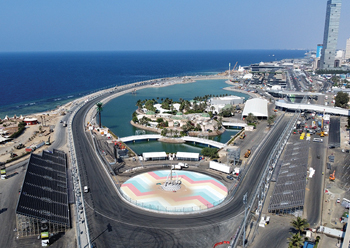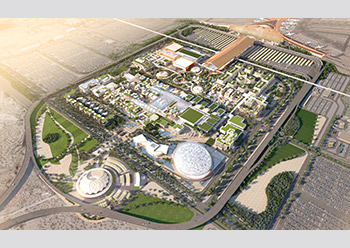
 Overview of Airport City.
Overview of Airport City.
A new transport-orientated urban development is set to take shape adjacent to King Abdulaziz International Airport in Jeddah, Saudi Arabia.
Chapman Taylor, a multi-award winning practice of global architects and masterplanners, has created the 1.91-million gross building area (GBA) masterplan for a new urban district that introduces an innovative mixed-use community concept to the region, creating diverse tourism and business opportunities while providing a dynamic lifestyle and family entertainment venue.
The developmemt, for SARH Airport Development and Real Estate Investment, will be located directly in front of King Abdulaziz International Airport, acting as a new hub gateway to Jeddah and beyond.
 |
|
The international exhibition centre in Zone One. |
“The Airport City masterplan vision creates a sustainable new-generation city district, unique for its human scale and fully pedestrianised urban community, with a perfect synergy between landscape and architecture,” says Chapman Taylor’s Madrid Director Jan Dijkema.
The masterplan design emphasises plug-and-play flexibility and high connectivity, with designs inspired by nature, history and traditional local architecture and art, in addition to careful planning, well-curated community spaces and an in-depth understanding of user requirements. It will be a special place in Jeddah, creating a new type of urban destination in a strategically important gateway location, he adds.
Airport City is divided into four zones surrounding the masterplan’s central spine and interconnected via a green circuit with a low-speed tramway, according to Dijkema.
Zone One is the Exhibition Circuit, which will host a stunning, 70,500-sq-m international exhibition centre with 5,000 sq m of additional exterior exhibition space, directly connected by an air-conditioned bridge promenade to an adjacent five-star hotel. There will also be a large three-star hotel, a mall and a modern village retail and food and beverage (F&B) street surrounded by a green central park with attractions and water features.
 |
|
The Museum of Saudi Art and Culture ... a landmark feature in Zone 4. |
Zone Two is the Business District, with 126,500 sq m of flexible, future-orientated office space, a mosque, a four-star hotel, a three-star hotel and serviced apartments next to a “floating village” with restaurants and terraces, all connected to the central park.
Zone Three is the Lifestyle Centre and Fun Zone, hosting a wide range of spaces and activities. It will include a four-star hotel, a three-star hotel, a health and wellness centre and more office and co-working space. There will also be a 20,000-seat multipurpose arena, a sport and leisure area and a co-retail patio courtyard with fully furnished workshops. The latter will sit within the Lifestyle Centre, which contains an “art walk”, a showcase area for future retail, an F&B street, a cinema, retail, family entertainment, a festival plaza, an aquarium, media/financial offices, a food market, a food hall and a sport-branded pavilion.
Finally, Zone Four will be the setting for a ‘Calm Community’ containing duplexes and apartments within the quietest area of the site, all sitting above a ground floor level which includes amenities such as laundries, children’s play areas, a nursery, prayer rooms and common social areas. The Museum of Saudi Art and Culture will be a landmark feature in this zone’s landscape, with an outdoor sculpture park surrounding it. It will include exhibition galleries for permanent and temporary exhibitions and interactive zones for adults and kids.
Airport City will have a well-connected urban structure with interaction between activities. Sustainability is embedded in the design, including the use of responsibly sourced materials, renewable energy technology and efficient space design. Ecological conservation is considered throughout the masterplan design, he adds.
 |
|
The central park in Zone One. |
The architecture blends the modern with the traditional. The designs of some buildings refer to the local architectural vernacular of Jeddah’s historic Al-Balad district; two special elements on their facades will be the Rowshans – which are projected wooden skeletons covered with decorative wooden panels – and the Mashrabiyas. These will respond well to climatic (ventilation and lighting) and social (privacy and decorative) factors.
The compact urban design provides many cooler, shaded spaces, while the masterplan proposes a vehicle-free above-ground space, where the pedestrian is the priority. The vehicular circulation is in the basement, leaving access to the drop-off spaces on the perimeter of the plot. Ground level only allows the circulation of buggies, public trams and bicycles that will circulate at low speed, says Chapman Taylor.
The masterplan incorporates several strategies for maximising the environmental sustainability of Airport City. The aim of the architectural approach is to minimise or eliminate any negative environmental impacts through skilful, sensitive design, efficiency and the responsible use of materials, energy, development space and the ecosystem at large.
According to Dijkema, key sustainability tools will include evaporative cooling; the various areas of the masterplan will be linked by numerous water features that will connect with the buildings and the landscape, with these features lowering the temperature. Areas will be shaded by indigenous trees and well-considered canopy compositions.
Rainwater will be harvested and stored while greywater will be recycled to be used for irrigation. Creepers and succulent plants and drought-tolerant wildflowers will be planted throughout the scheme. There will also be abundant use of green roofs and shaded courtyards.
Shading elements will be used for windows and walls to control the amount of solar radiation that the buildings receive, he says. Ventilated façades and roofs will be built and the designs also make use of high-efficiency glass. Meanwhile, the green roofs will retain rainwater, purify the air, reduce the ambient temperature, insulate against noise, save energy and promote biodiversity in the city. The plants will absorb heat, protecting the buildings from overheating.
The masterplan also foresees the use of resource-efficient equipment such as LED lights, presence detectors that avoid illuminating uninhabited spaces, taps that limit water flow, etc. Inmotic or domotic systems will control and optimise the operation of all mechanical equipment. Photovoltaic solar panels will be placed across building roofs, he adds.
“Airport City will be a central element to the future development of the city to the north, and the site will act as a link between the city and the airport, with excellent connections to the rest of the city,” says Dijkema.
“The client’s objectives are to capitalise on the wonderful strategic location, creating an elegant, modern and human-scale community. A central part of the brief is to design flexibility into the development to allow for easy adaptation to social and market-led changes and to achieve the most efficient and sustainable solutions,” he says.
When putting the Airport City masterplan together, Chapman Taylor aimed to create a vibrant new community in Jeddah, with designs inspired by nature, history and art in addition to careful planning of well-curated community spaces.
“The Airport City’s vision is to capture broad opportunities in tourism and business while also providing a dynamic lifestyle and family entertainment hub,” he says.








.jpg)




.jpg)




























.jpg)
































